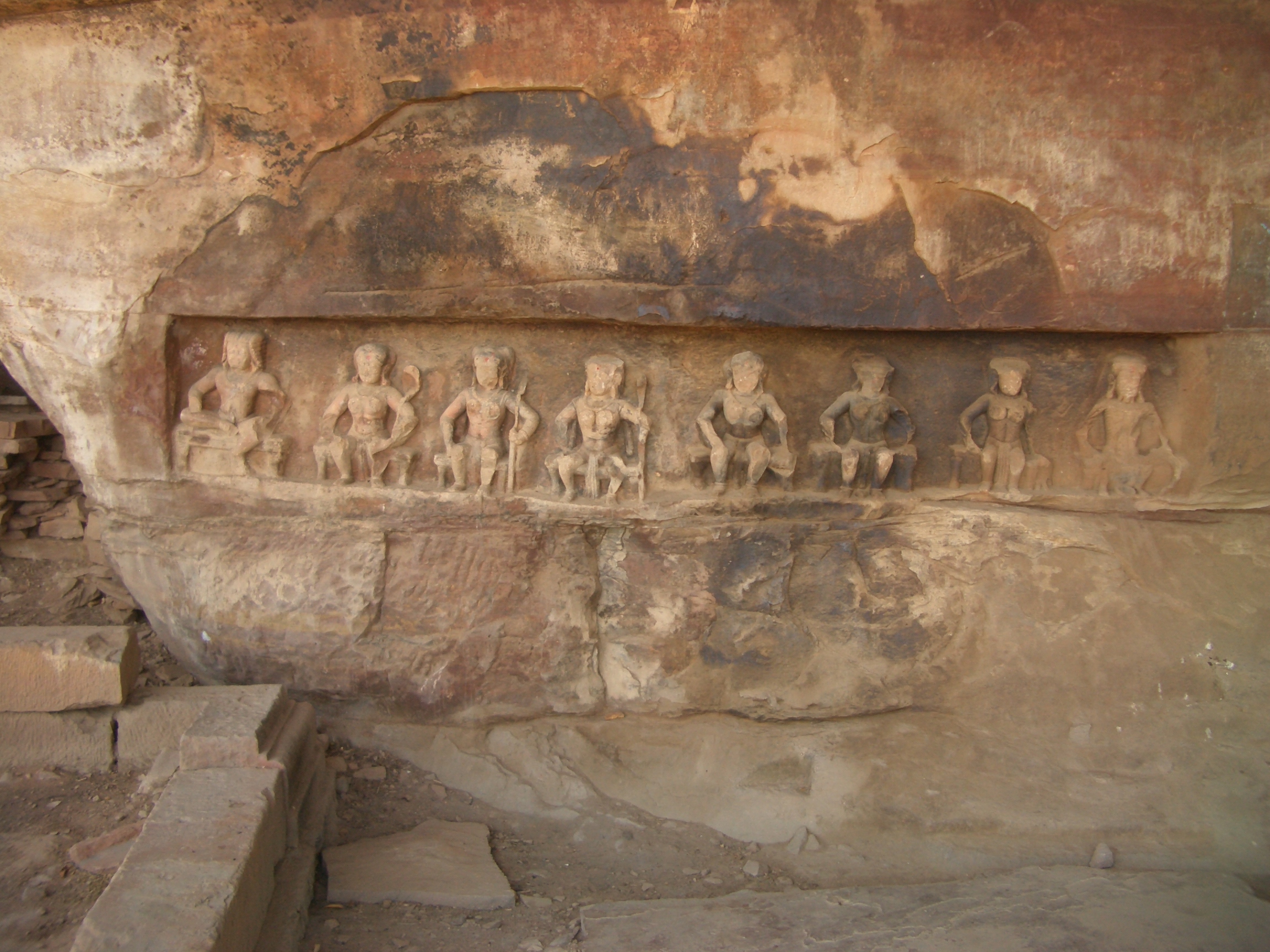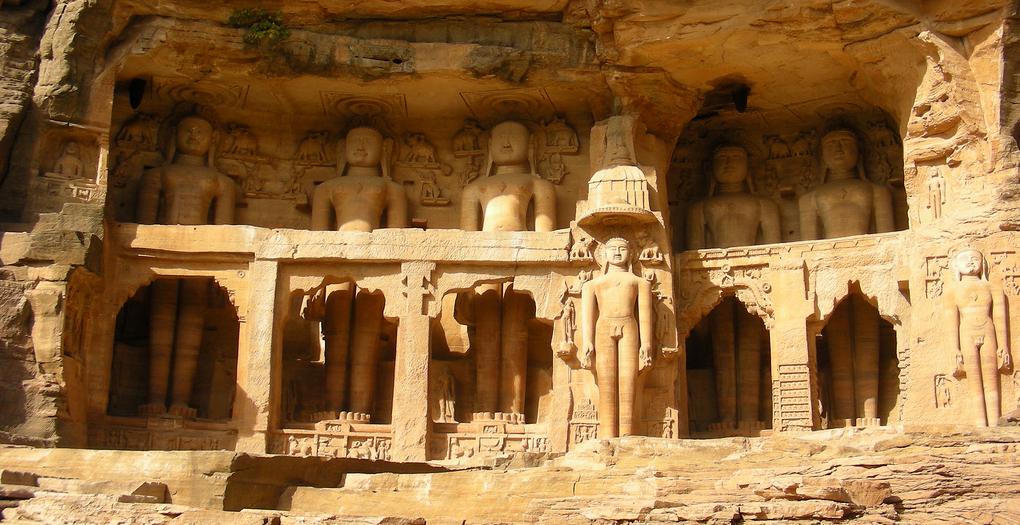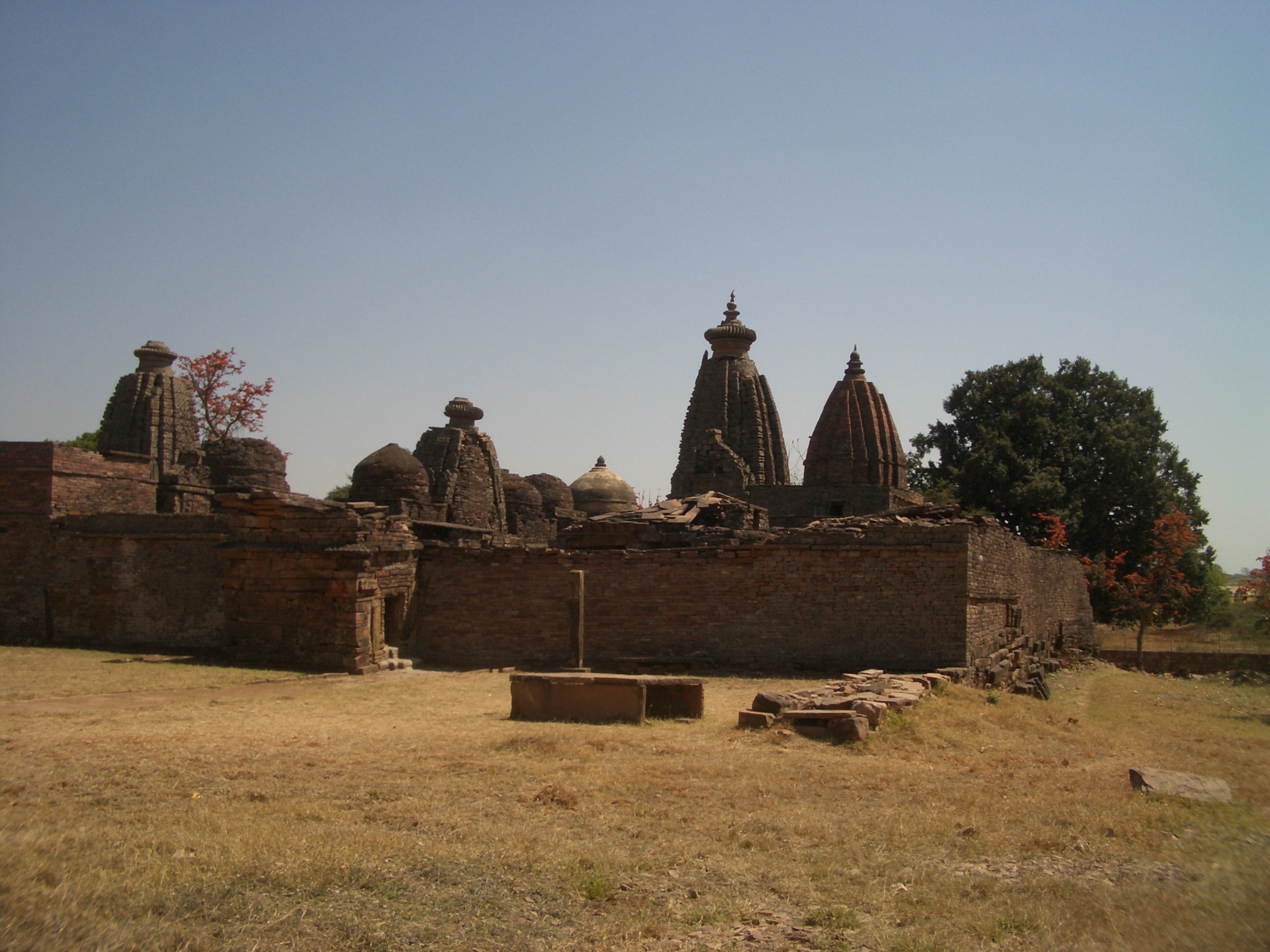Madhya Pradesh has the proud privilege of having preserved relics and monuments of art in a remarkable manner. Jainism flourished there from very early times and has left its vestiges in the form of art and architecture. The Medieval Jaina art has characteristics of profuse ornamentation and iconometry. The iconographic details of the Jaina pantheon had been worked out in the Gupta period. The artists were compelled to pay more attention to the prescribed iconic norms than to the aesthetic sense of composition.
The iconographic forms of quite a large number of deities and semi-divine figures in the Jaina pantheon had already been thoroughly worked out by then, both in the Digambara and in the Shvetambara sects. Apart from the statues of the twenty-four Tirthankaras, those of the sixteen Vidya-devis, twenty-four Sasana-devas (both Yakshas and Yakshis) the Kshetra-palas,, eight Matrikas, ten Dik-palas and nine Grahas were made in the prescribed forms. Some of the medieval Jaina texts mention sixty-four Yoginis, eighty-four Siddhas and fifty-two Viras, who had assumed the forms of popular divinities. The theological complex of the religion had gained ground in several parts of the country. The profuse development of temples and images gave an impetus to this complex during the late medieval period.
The business-community of the Medieval period was largely Jaina. A peaceful atmosphere for an undisturbed progress of trade and commerce was essential. Hence the Jainas strove hard to help the rulers of their respective regions in maintaining a congenial atmosphere and, as far as possible, strived to avoid warring tendencies.

Rock-carvings of Saptamatrikas near Badoh Pathari
Even in the earlier period, several Jain sacred places, the Siddha-kshetras and Atisaya-kshetras, had assumed considerable importance. In central India, a number of them were located on hillocks or on the banks of rivers and lakes, some with pleasant natural surroundings. During this period places like Sonagiri, Dronagiri, Nainagiri, Pavagiri, etc., became famous. At these and other sites in Malwa, Gwalior and Bundelkhand temples were erected and statues of various types made.
The sculptural art of the Medieval period is marked by a profusion and a peculiar liking for the colossus. Carving of huge stone images of Tirthankaras became a fashion. The rise of the Gommata cut was largely responsible for this, the notable example at Shravanabelgola perhaps providing the inspiration. At Gwalior, Ahar, Banpur, Barhata, Deogarh, Bahuriband and several other places in central India huge images were carved and enshrined. Some of them were in the form of standing statues.
Besides the Tirthankara images, a large number of statues of Sasana-devas, Nagas, Nava-grahas, Kshetra-palas, Gandharvas, Kinnaras, etc. are still preserved. To the number of the early goddesses, Sarasvati, Ambika, Padmavati and Cakreshvari, numerous other Devis were added. Depiction of the Jain Puranic stories and of folk-life in general was also favourite with the contemporary artists. Natural scenes are also met with here and there.
The profuse plastic art of the period is primarily marked by a sense of iconographic profusion. It is, however, not invariably devoid of the aesthetic sense, which real artists could not miss. Some of the figures of gods and goddesses, apsaras, etc., do indicate a proper sense of anatomy and expression. But the number of such figures is rather limited and, on the whole, the early tradition of aesthetic excellence in plastic art was broken. It was, therefore, not possible to expect the originality, freshness and emotional exuberance of the earlier epochs in the art of the late Medieval period. The Hindu rulers of Gwalior, Marwar, Orchha, Rewa and Gondwana and the Sultanas of Mandu patronized fine arts. The numerous monuments preserved in central India eloquently speak of the encouragement given to fine arts during this period.

Colossal Jina statues at Gwalior
In the Bundelkhand area black granite was used along with the sandstone for construction work. In other parts of central India sandstone of different varieties was utilized for building temples and carving out images.
In the Gwalior area artistic activities continued in the period. The Gwalior fort has preserved some colossal Tirthankara images hewn out of the rock. These are preserved in the Gwalior fort.
The Tomaras of Gwalior and their successors gave a fillip to architecture, sculpture, painting and music. The name of Manasimha Tommara is well-known in this respect. At Narwar (ancient Nalapura), 40 km north-east of Shivpuri, several Jaina temples and statues were made. The white stone used for temples and images there was polished and gave the appearance of marble. Kings Yajvapala, Gopaladeva and Asalladeva of Narwar largely contributed to the development of art.
Tumain and Chanderi in Guna district were other important art-centres. Quite a large number of stone sculptures of the period have been obtained at Chanderi and the area around. They represent the Tirthankaras, goddesses and other images, several of them inscribed. By about 1400 A.D., the Chanderi patta had been established. Its pontiff Bhattaraka Devendra Kirti and his successors played an important role in the diffusion of Jain literature and religion in that area. Sironj in Vidisha district was under the orbit of the Bhattarakas of Chanderi. The Bhattaraka doctrines, originated and developed at Devagarh, Gwalior, Chanderi, and Sironj spread in the far:off region of Karnataka.
In the Malwa region, Jainism flourished throughout the Medieval period. At Ujjain and the area around, Jaina temples and images continued to be made after the rule of the Paramaras. Bhanpura in Mandsaur district witnessed the growth of Jaina art, Numerous art-relics of the period have been discovered there. At Maksi, near Ujjain during the fifteenth century both the Digambara and Shvetambara sects had their establishments. The well-known temple of Parshvanatha was built here by Sangramasimha Soni in 1461 A.D. At Dhar (ancient Dhara) inscribed images of the fourteenth and fifteenth centuries are preserved in a temple at Baniawadi. Dhar was a great centre of study and research in ancient Vedic and Jain a lore.
Mandu (Mandavapura) near Dhar is known for its famous monuments built during the Medieval period. Several Jaina scholars occupied important positions in the kingly courts. Among these mention may be made of Pethad Shah, Jhanjhana and Mandana, who patronized Jaina religion and art. They were responsible for building several Jaina temples and statues. Badwani is known as Siddhanagara with several Jaina temples. An image of Adinatha, carved in the rock, is 26 metre high. On the hillock called Culagiri, there are twenty-two Jaina temples. At Alirajpur in Jhabua district, several lovely Jaina statues and temples were carved.
At Vidisha, the ancient art-centre, temples and statuary continued to be made during the period. Images of Nagas and Nagis, and Yakshas and Yakshis of the period have been discovered at Vidisha. At Badoh and Pathari in the same district several Jaina temples, having some fine stone images, were made. At Samasgarh near Bhadbhada, district Bhopal, some colossal Tirthankara images and decorated architectural pieces of the thirteenth century have been found.

Badoh Pathari temple complex
The Vindhya region (Bundelkhand and Baghelkhand) witnessed great activity of Jaina plastic art during the Medieval period. Mention may be made of Deogarh, Thubon, Sonagiri, Dronagiri, Kundalpur, Papaura, Ahar, Rehli, Bina-Barha, Banpur, Barhata, Pajnari and several other sites, where extensive art-activity took place. At Thubon, Kundalpur Bina-Barha and Ahar, Building-work continued for a considerable length of time after the twelfth century A.D.
Bina-Barha, district, Sagar, 75 km. south-east of Sagar, is located on the bank of the river Sukhchain. It has two temples and a gandha-kuti. The first temple is that of Candraprabha. The image of the deity was installed in the temple in 1775 A.D. by Bhattaraka Mahendrakirti. In the temple is an image of Mahavira, about 4 metre high. The second temple is of Shantinatha built in 1746. The image of Shantinatha enshrined here is in Khadgasana and is over 5 m. high. The gandha-kuti is located at a considerable height.
Ahar is situated 20 km. east of Tikamgarh. This sacred place was tastefully beautified by the Candella rulers, who constructed there several buildings and ponds. The extant temples there were built in the eleventh and the succeeding centuries. Apart from the temples of Santinatha and other Jainas and of Bahubali, there are several manastambhas. Inscriptions on the pedestals of images give an account of several branches of the Jainas, who contributed to the development of this centre. A site museum has been set up at Ahar.
At Banpur, near Tikamgarh, is an interesting shrine representing a sarvatobhadra-sahasra-kuta, with a door on each of the four directions. The shrine, of the Nagara style is built on the-square basement, about 1 m high. Its entire composition, the decorated pillars, ceilings, garbhagriha and tapering shikhara are remarkable indeed. The decorative arrangements of the river-goddesses, the Navagrahas and the foliage-work are also exquisitely done. The images of Adinatha and Sarasvati and of other deities have been tastefully carved. Near Tikamgarh the other two sacred Jaina centres are at Papaura and Navagarha.
Dronagiri, in Chhatarpur district, is another important siddha-kshetra. It has thirty Jaina shrines located on hillocks commanding the scenic beauty of the area. The temples were constructed there between 1483 and 1539 A.D. Sonagiri, Nainagiri, Graha, Golakot, Panjari, and Ajaigarh are other sites worth mention where Jaina art and architecture grew up during the period. At Ajaigarh, district Panna, in the reign of the Canella king Viravarman, a remarkable image of Shantinatha was enshrined in 1279 A.D. The work of construction continued there till later times. At Naunia, near village Barhata in Narsinghpur district, are seen colossal statues of Adinatha, Candraprabha and Mahavira. The site was a Jaina centre from the eleventh to fourteenth centuries A.D.
Apart from the stone images, metal images of a few Tirthankaras, particularly of Adinatha, Parsvanatha and Mahavira, were cast during the period. Images in metal were also made of goddesses Sarasvati, Ambika, Cakreshvari, etc. They were of gold, silver, ast-dhatu or of bronze. These are preserved in various temples, and in the museums at Gwalior, Indore, Raipur, Dhubela and Nagpur.
 Prof. K.D. Bajpai
Prof. K.D. Bajpai